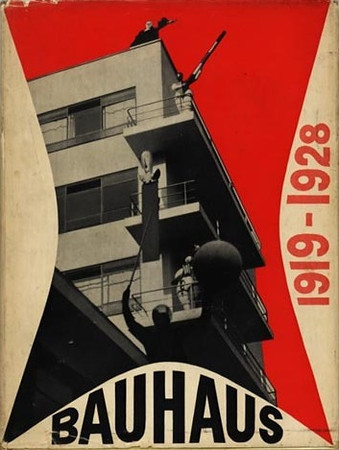Herbert Bayer, Walter Gropius, Ise Gropius (eds.): Bauhaus 1919–1928 (1938)
Filed under book, catalogue | Tags: · 1920s, architecture, art, art history, avant-garde, bauhaus, design, graphic design, industrial design, painting, photography, sculpture, typography


Bauhaus 1919-1928 remains one of the most valuable accounts of the Bauhaus school. The book was published in conjunction with the Museum Of Modern Art exhibition (December 7, 1938-January 30, 1939) and is a point-for-point record of actual programs and projects at the Bauhaus, prepared by Herbert Bayer under the general editorship of Walter Gropius and Ise Gropius and with the collaboration of a dozen other Bauhaus teachers — including Kandinsky, Klee, Feininger, Schlemmer, Itten, Moholy-Nagy, Albers, and Breuer. Rather than a retrospective history, it is a collection of photographs, articles, and notes prepared on the field of action. It may be considered as much a work of the Bauhaus as it is a work about it.
Includes work by all the Bauhaus faculty including Walter Gropius, Paul Klee, Wassily Kandinsky, Laszlo Moholy-Nagy, Marcel Breuer, Herbert Bayer, Josef Albers, Lyonel Feininger, Oskar Schlemmer, Hannes Meyer, Mies van der Rohe, Anni Albers, Otti Berger, Gunta Stolzl, Max Bill and many others.
The exhibition gave the first comprehensive review of the development of the institute under Gropius (no material from the later Bauhaus was shown). Preparation and technical arrangements were entrusted to Herbert Bayer, paving the way for his own emigration to America shortly afterwards. An accompanying Bulletin was a privilege, sent to members of MOMA. (Source)
Bauhaus 1919-1928
With a Preface by Alfred H. Barr, Jr.
Publisher Museum of Modern Art, New York, 1938
224 pages
via Joaquim Moreno, update via MoMA
The Bulletin of the Museum of Modern Art 6, Vol. 5 (Dec 1938): Bauhaus Exhibition
Publisher Museum of Modern Art, New York, 1938
8 pages
via David Levine
PDF (Book, 42 MB, updated on 2016-9-17)
PDF (Bulletin)
Wendy Bark: Constructivist Costume, Textile & Theatrical Design, 1917-1934 (1995)
Filed under thesis | Tags: · 1910s, 1920s, 1930s, art history, constructivism, costume design, design, fashion design, textile design, theatre

This thesis follows the life of the art movement known as Constructivism through the turbulent post-revolutionary years, up to the onset of Socialist Realism, a doctrine imposed on the Arts by governmental directives. It focuses on the areas of fashion, textile and theatrical design, which themselves are strongly influenced by extra-artistic factors – economics, sociology and the historical era – as was the ethos of Constructivism.
After a brief introduction giving some background information on the art world and the main artist-designers of the study, the chapters go on to discuss the factors affecting the rise and then the waning popularity of the constructivist ideology, explaining the focal tenets of Constructivism, particularly in relation to fashion, textile and theatrical design. Since the majority of constructivist works were completed during the time span covered by NEP, those chapters relating to NEP have thus been given emphasis. Some biographical details about the main artists of the study are given at the end, and the Glossary lists the most common acronyms and abbreviations used in the text. The illustrations are intended as a companion to the text, since often the artistic effects of designers cannot be described adequately by language alone.
The study focuses on six artist/designers: Vladimir Tatlin, Alexander Rodchenko, Varvara Stepanova, Liubov Popova, Alexandra Exter, and Nadezhda Lamanova.
Full title: Constructivist Costume, Textile & Theatrical Design, 1917-1934: A Study of Constructivism Set in the Socio-cultural, Political and Historical Context of Post-Revolutionary Russia
Masters thesis
Durham University
285 pages

